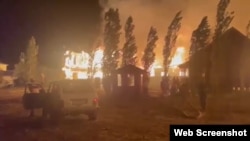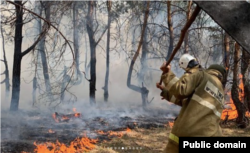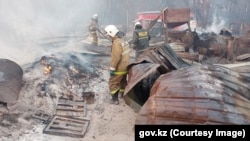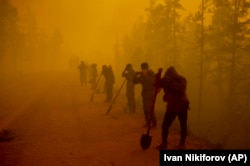ALMATY, Kazakhstan -- By the time they saw fierce flames from a forest fire encroaching on their village in Kazakhstan’s northern region of Qostanai, residents in the village of Amanqaraghai hardly had time to jump in their cars and flee.
Yevgeny Kovalenko was coming in the other direction from work after a neighbor called to tell him that the raging inferno had reached his property.
Opening the door of his smoke-engulfed barn, Kovalenko saw his cow being burned alive.
The 29-year-old fainted and only avoided death or burns thanks to the arrival of firefighters and medics in the village right after he lost consciousness.
The horrors of the fire that raged in Kazakhstan from September 2-7, killing one, injuring more than dozen others, and destroying or damaging nearly 100 homes in Amanqaraghai, were still fresh in the minds of evacuees holed up in a school in Aulieqol on September 5.
Growing up in a state children's home, owning a house and livestock had been a lifelong ambition for Kovalenko, he told RFE/RL's Kazakh Service.
Now his hopes of restoring his modest quality of life depends on the level of compensation the government can offer, he said.
This corner of Kazakhstan, close to the border with Russia, is no stranger to wildfires, which threaten farmland as well as the forests that occupy a mere 4 percent of Kazakhstan.
Anetta Kozlova, who also lost her home in the blaze, told RFE/RL's Kazakh Service that a fire two years ago had threatened the village of 2,000 people without reaching its outskirts.
This time around, "Amanqaraghai was shrouded in smoke," Kozlova recalled, close to tears. "We only had time to save some documents and money. It was like a war. Then, the rescuers came. Everybody helped each other, we gave lifts to people on foot, bundled the elderly into cars. I wouldn't wish this on anybody."
Back in smoldering Amanqaraghai, RFE/RL correspondents found some villagers venturing back through the ruins. "There is nothing left of my home," said one. "If I can find some metal I will collect it and sell it for scrap."
Qostanai, where the fire burned some 43,000 hectares of territory according to the Emergency Situations Ministry, was one of several Kazakh regions where forest and steppe fires hit during an unusually warm week in September.
Satellite data sourced by AgriTech Hub Kazakhstan and published by agriculture consultant Kirill Pavlov on the Kazchuvash Telegram channel showed that an additional 110,000 hectares of land had been damaged by fire in the Abay, Karaganda, and Pavlodar regions.
But the fire in Qostanai was by far the most dramatic, affecting Amanqaraghai and four other villages in prompting some 2,000 evacuations and the closure of the road through the region.
Farmland was also damaged, although the Agriculture Ministry was quick to a release a statement saying the fires would "not affect the country's food security, the projected yield, and the export agreements with foreign states," all of which are of increased global interest due to ongoing food-security concerns connected to Russia’s unprovoked invasion of Ukraine.
Overall, the ministry said, the fires had affected less than 0.1 percent of the crop-rich region's farmland.
Footage of the devastation soon gave rise to conspiracy theories about deliberate fires started by saboteurs, both local and foreign.
Those theories were strengthened by political coincidence, as President Qasym-Zhomart Toqaev had planned a visit to the region, ostensibly to mark the 150th anniversary of Akhmet Baitursunov, an intellectual and leader who was killed during Soviet dictator Josef Stalin's repressions.
Toqaev instead ended up surveying the havoc wrought by a blaze from a helicopter before pledging state compensation and the rebuilding of homes in the space within two and a half months during a meeting with victims on September 5.
However the Qostanai fire began, climatic conditions certainly played a role in exacerbating the blazes, some experts said.
On the day the fire struck, the regional capital, also called Qostanai, experienced temperatures between 22 and 38 degrees, some 11 and 8 degrees higher, respectively, than last year, when Kazakhstan had just experienced a prolonged and destructive summer drought.
Daytime highs in Qostanai in July, the hottest month of the year, typically hover around 27 degrees Celsius.
In addition to hot, dry weather, powerful winds helped fuel the fire and put for firefighters in peril.
In the eastern Abay region on September 7, three members of an Emergency Situations Ministry fire brigade found themselves encircled by a steppe fire that had suddenly changed direction, sweeping into an area surrounded by trees where they were refilling their firetruck with water.
The men abandoned the truck but did not escape serious burns. Driver Aidos Toguzbaev, a 36-year-old father of five, died at the hospital, the ministry said.
Last year, as Kazakhstan experienced a drought that caused mass livestock deaths in several areas of the country, large swathes of Russia's mostly uninhabited taiga areas were ablaze, with even a one-time climate-change skeptic, President Vladimir Putin, admitting the problem was "unprecedented."
The fires in Siberia and the Far East had the hallmarks of a major climate event, with over 18 million hectares of forested area burned in total.
But Russia remains the world's most forested country by some distance -- trees cover almost half of its territory.
For its neighbor to the south, says Vadim Ni, chairman of the nonprofit Socio-Ecological Fund in Almaty, the risk posed by "more intense fires, covering larger areas" is the complete loss of limited forest land and the biodiversity accompanying it.
A big contributor, Ni said, is the expansion of human activity toward forested areas, such as spa resorts and dachas.
But a warming climate will increase the chances of tragedies such as the one in Qostanai, he added.
"If traditionally in autumn we see sharp temperature drops from day to night, then the risk of climate change is that temperatures don't fall so much," Ni told RFE/RL.
"That makes it easier for the blazes to gather strength and last longer."















